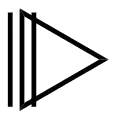Cyclopropyne
 | |
| Names | |
|---|---|
| Preferred IUPAC name
Cyclopropyne | |
| Identifiers | |
3D model (JSmol)
|
|
PubChem CID
|
|
CompTox Dashboard (EPA)
|
|
| |
| |
| Properties | |
| C3H2 | |
| Molar mass | 38.049 g·mol−1 |
Except where otherwise noted, data are given for materials in their standard state (at 25 °C [77 °F], 100 kPa).
Infobox references
| |
Cyclopropyne is an extremely strained, unstable, and reactive cycloalkyne with the chemical formula C3H2.[1][2] As the smallest cycloalkyne, it features a three-carbon ring that includes a triple bond. The significant ring strain makes the compound challenging to produce and causes its high reactivity.[3]
Theoretical studies
Although cyclopropyne is challenging to isolate, it has been extensively investigated through theoretical studies aimed at exploring its electronic structure, energy properties, and vibrational characteristics. A similar compound called silacyclopropyne, in which a silicon atom substitutes one of the carbon atoms in the ring, has been successfully synthesized and examined.[4][5]
See also
References
- ^ Dodziuk, Helena (30 March 2009). Strained Hydrocarbons: Beyond the van't Hoff and Le Bel Hypothesis. John Wiley & Sons. p. 376. ISBN 978-3-527-62714-1. Retrieved 7 August 2025.
- ^ "Cyclopropyne properties - SpringerMaterials". Springer. Retrieved 7 August 2025.
- ^ Saxe, Paul; Schaefer, Henry F. III (1 April 1980). "Can cyclopropyne really be made?". Journal of the American Chemical Society. 102 (9): 3239–3240. Bibcode:1980JAChS.102.3239S. doi:10.1021/ja00529a057. ISSN 0002-7863. Retrieved 7 August 2025.
- ^ Brandow, Christopher G.; Allen, Wesley D.; Henry F., Schaefer III (31 July 1996). "Cyclopropyne and Silacyclopropyne: A World of Difference". ACS Publications. 118 (30): 7158–7163. Bibcode:1996JAChS.118.7158S. doi:10.1021/ja960762n. Retrieved 7 August 2025.
- ^ Sherrill, C. David; Brandow, Christopher G.; Allen, Wesley D.; Schaefer, Henry F. (1 January 1996). "Cyclopropyne and Silacyclopropyne: A World of Difference". Journal of the American Chemical Society. 118 (30): 7158–7163. Bibcode:1996JAChS.118.7158S. doi:10.1021/ja960762n. ISSN 0002-7863. Retrieved 7 August 2025.